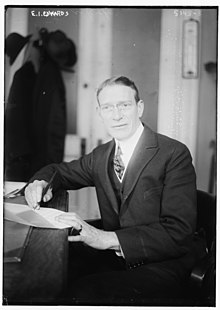Edward I. Edwards

 Clash Royale CLAN TAG#URR8PPP
Clash Royale CLAN TAG#URR8PPP | Edward I. Edwards | |
|---|---|
 | |
| 37th Governor of New Jersey | |
In office January 20, 1920 – January 15, 1923 | |
| Preceded by | Clarence Edward Case as Acting Governor |
| Succeeded by | George Sebastian Silzer |
United States Senator from New Jersey | |
In office March 4, 1923 – March 3, 1929 | |
| Preceded by | Joseph S. Frelinghuysen |
| Succeeded by | Hamilton F. Kean |
| Member of the New Jersey Senate | |
In office 1918 | |
| Personal details | |
| Born | Edward Irving Edwards (1863-12-01)December 1, 1863 Jersey City, New Jersey, U.S. |
| Died | January 26, 1931(1931-01-26) (aged 67) Jersey City, New Jersey, U.S. |
| Political party | Democratic |
| Spouse(s) | Blanche Smith (1888-1928; her death) |
| Children | 2 |
Edward Irving Edwards (December 1, 1863 – January 26, 1931) was an American Democratic Party politician who served as the 37th Governor of New Jersey from 1920 to 1923 and in the United States Senate from 1923 to 1929.[1]
Contents
1 Life and career
2 Death
3 See also
4 References
5 External links
Life and career
Edwards was born in 1863 in Jersey City, New Jersey, the son of Emma J. (Nation) and William W. Edwards. Edwards attended the Jersey City public schools and New York University. He later studied law in the office of his brother, William David Edwards, who was also a state senator.[2] On November 14, 1888, he married Blanche Smith. They had two children, Edward Irving, Jr. and Elizabeth Jules. He engaged in banking and in the general contracting business. He later became president and chairman of the board of directors of the First National Bank of Jersey City.[1]
Edwards entered politics and became part of the Democratic Organization, being elected state senator in 1918. He became a friend and close political ally of Mayor Frank "Boss" Hague, who ran the Democratic machine in Hudson County, and later the whole state of New Jersey. Hague supported Edwards's gubernatorial run in 1919.
At the end of his term, forbidden by the state constitution to run for a consecutive term, he ran for the United States Senate in 1922. Campaigning against the 18th Amendment (Prohibition) and with the support of the Hague Democratic Political Machine, Edwards defeated incumbent Republican Joseph S. Frelinghuysen by almost 90,000 votes and served from March 4, 1923 to March 3, 1929.
After six years in the Senate, Edwards ran for re-election against Republican Hamilton Kean in 1928. Kean came out against Prohibition also which hurt Edwards who used his "Applejack Campaign" so successfully in the past. Also, Edwards could not overcome the "Coolidge Prosperity" that was sweeping the country. He lost by over 230,000 votes, having 41.8% of the vote to Kean's 57.8%.
After returning to Jersey City in March 1929, his luck turned for the worse. His wife had died in 1928 and his relationship with Mayor Hague went downhill when Hague supported A. Harry Moore instead of Edwards for governor. He went broke in the Wall Street Crash of 1929 and was implicated in an electoral fraud scandal.
Death
He was diagnosed with skin cancer and shot himself in his apartment at 131 Kensington Avenue in Jersey City, New Jersey on January 26, 1931.[1] He was 67 years old. He was buried in Bayview – New York Bay Cemetery in the plot of his older brother, William David Edwards, who died in 1916.
See also
- List of Governors of New Jersey
- List of people with reduplicated names
References
^ abc "Edward I. Edwards Ends Life By Bullet. Ex-Senator And Governor Of New Jersey Found Dead In His Apartment". New York Times. January 27, 1931.
^ The Political Graveyard
External links
Biography for Edward I. Edwards (PDF), New Jersey State Library
United States Congress. "Edward I. Edwards (id: E000066)". Biographical Directory of the United States Congress. for Edward Irving Edwards
New Jersey Governor Edward Irving Edwards, National Governors Association
| Political offices | ||
|---|---|---|
| Preceded by Clarence Edward Case Acting Governor | Governor of New Jersey January 20, 1920 – January 15, 1923 | Succeeded by George Sebastian Silzer |
U.S. Senate | ||
| Preceded by Joseph S. Frelinghuysen | U.S. Senator (Class 1) from New Jersey March 4, 1923 – March 4, 1929 | Succeeded by Hamilton F. Kean |
| Party political offices | ||
| Preceded by H. Otto Wittpenn | Democratic Nominee for Governor of New Jersey 1919 | Succeeded by George Sebastian Silzer |
| Preceded by James E. Martine | Democratic Nominee for the U.S. Senate (Class 1) from New Jersey 1922, 1928 | Succeeded by A. Harry Moore |




Comments
Post a Comment